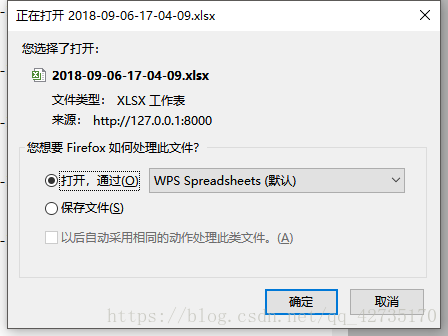from django.http.response import HttpResponse, JsonResponse
import datetime
import os
import xlwt
import xlrd
from django.http import StreamingHttpResponse
def Export_excel(request):#生成EXCEL表格
if request.method=='POST':
try:
now = datetime.datetime.now()
file_path = os.path.join(r'static/excel/','%s.xlsx'%now.strftime("%Y-%m-%d-%H-%M-%S"))
f=list(os.listdir(mailpath))
#列出实例化的路径下面的文件(根据时间只保留最新创建的excel文件,其中mailpath填写自己的excel保存路径http://blog.51cto.com/net881004/2052066)
for i in range(len(f)): #len统计多少个文件,然后循环赋值给变量i。
maildate = os.path.getmtime(mailpath + f[i]) #获取每个文件的时间的时间
currdate = time.time() #当前时间
num1 =(currdate - maildate)/60 #当前时间减去文件时间,然后换成乘天。
if num1 > 0:
try:
os.remove(mailpath + f[i])
except Exception as e:
print(e)
wb = xlwt.Workbook(encoding='utf-8')#开始创建excel
LST_test = wb.add_sheet(now.strftime("%m-%d"))#excel中的表名
LST_test.write(0, 0, '编号') #列名
LST_test.write(0, 1, '用户id')
LST_test.write(0, 2, '创建时间')
row = 1
datas =[#要用到的数据]
for i in datas:
LST_test.write(row, 0, int(i.id))#row为每一行要添加的数据,0为第几列,最后的是要添加的数据
LST_test.write(row, 1, i.user_id_id)
LST_test.write(row, 2, i.create_time.strftime("%Y-%m-%d %H:%M:%S"))
row = row + 1
wb.save(file_path)#保存
return JsonResponse({'code':0,'data':file_path})#将路径返回到前台
except Exception as e:
print(e)
return JsonResponse({'code': 1, 'data': '导出表格失败!'})#这里是前台html代码
function Export_excel(arg){
$.ajax({
url:'/Export_excel/',
type:'post',
data:{},#自己要传的数据
success:function(arg){
if (arg.code===0){
window.location.href='/download?data='+arg.data+'';
}else{
alert(arg.data)
}
},error:function(){
alert('导出失败');
}
})
}#下载的方法
Django的HttpResponse对象允许将迭代器作为传入参数,将上面代码中的传入参数c换成一个迭代器,便可以将上述下载功能优化为对大小文件均适合;而Django更进一步,推荐使用StreamingHttpResponse对象取代HttpResponse对象,StreamingHttpResponse对象用于将文件流发送给浏览器,与HttpResponse对象非常相似,对于文件下载功能,使用StreamingHttpResponse对象更合理。
链接:https://www.jianshu.com/p/ce8c17b4a7fd
def download(request):
try:
filename = request.GET.get('data',None)
def file_iterator(file_name):
with open(file_name, 'rb')as f:
while True:
c = f.read(512)
if c:
yield c
else:
break
response = StreamingHttpResponse(file_iterator(filename))
response['Content-Type'] = 'application/octet-stream'
response['Content-Disposition'] = "attachment;filename={0}".format(filename.split('/')[2])#这里改成自己需要的文件名
return response
except Exception as e:
print (e)
下面再 添加一个导入的函数
def read_excel(request):
if request.method == 'POST':
try:
img = request.FILES.get('file',None)#获得用户上传的excel
oldName = img.name
if str(oldName.split(".")[1]) == 'xlsx':#判断格式
filename = str(int(time.time() * 10)) + "." + oldName.split(".")[1]
dirpath = os.path.join(r'static/excel/',filename)
with open(dirpath,'wb+') as destination:
for chunk in img.chunks():
destination.write(chunk)
xlsfile =dirpath # 打开指定路径中的xlsx文件(读取excel的内容)
book = xlrd.open_workbook(xlsfile) # 得到Excel文件的book对象,实例化对象
sheet0 = book.sheet_by_index(0) # 通过sheet索引获得sheet对象
col_data1 = sheet0.col_values(0) #获得第一列的数据
col_data = sheet0.col_values(-1) # 获得最后1列的数据列表
return JsonResponse({'code':0})
else:
return JsonResponse({'code':2,'data':'请导入正确格式的表格!'})
except Exception as e:
print (e)
导入的前台代码
<label for="exampleInputFile"></label>
<input id='img' type="file" name="file"/>
<button style="border: 1px solid black;width: 60px;height: 30px;margin-top:30px;margin-left:30px;text-align: center;line-height: 15px;background:#c0c0c0;" onclick="FileUpload()">导入</button>function FileUpload() {
var form_data = new FormData();
var file_info = $('#img')[0].files[0];
form_data.append('file',file_info);
if(file_info===''){
alert('你没有选择任何文件');
return false;
}
$.ajax({
url:"{% url 'read_excel' %}",
type:'POST',
data: form_data,
processData: false,
contentType: false,
success: function(j) {
if (j.code === 0){
alert('导入成功!');
window.location.reload()
}else{
alert(j.data);
window.location.reload()
}
}
});
}最后
以上就是搞怪雨最近收集整理的关于django 一键生成excel表格并下载到本地,并根据时间删除文件,上传excel文件的全部内容,更多相关django内容请搜索靠谱客的其他文章。
本图文内容来源于网友提供,作为学习参考使用,或来自网络收集整理,版权属于原作者所有。








发表评论 取消回复